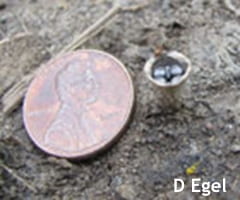– Nathan Kleczewski, Extension Specialist – Plant Pathology; nkleczew@udel.edu
Sclerotinia are fungi that cause what is commonly known as white mold in many vegetable crops as well as soybeans. The fungi produce dark, hard structures called sclerotia, which allow for prolonged survival in the soil in the absence of a host. The fungus produces fleshy, trumpet-like structures called apothecia (Figure 1) when temperatures are appropriate and humidity levels are high, often after canopy closure.
Figure 1. A sclerotium with five apothecia. Each apothecia will eject many infective spores into the crop canopy. Note the small size of the apothecia. Photo obtained from: http://ucanr.edu/blogs/salinasvalleyagriculture
Apothecia produce copious amounts of spores, which are ejected into the canopy. When these spores land on senescing tissues, most importantly flower petals, they germinate and grow into the plant stem, choking off water transport throughout the plant and ultimately causing wilt and plant death. When scouting fields, one may observe apothecia under the appropriate conditions, which may indicate a potential issue with white mold in the future in fields containing susceptible crops. Another group of fungi is present in many fields throughout Delaware that can be easily misidentified as Sclerotinia. These are called the “birds nest fungi.” These fungi produce cups containing multiple spore bearing, egg-shaped structures (Figure 2).
These are not pathogenic fungi, but instead are saprophytic fungi that decompose plant tissues in the soil. If you just cannot get enough information on birds nest fungi, you can check out the action packed video (With Nirvana’s “Smells Like Teen Spirit” as the background music) at this link: https://www.youtube.com/watch?v=EGlaQhDi5ts
Figure 2. The fruiting body of a birds nest fungus. Note that it is similar in size to Scletotinia apothecia, but contains “eggs” within the cup. There are many species of birds nest fungi, which vary in shape, cup, and “egg” color, among other traits.


